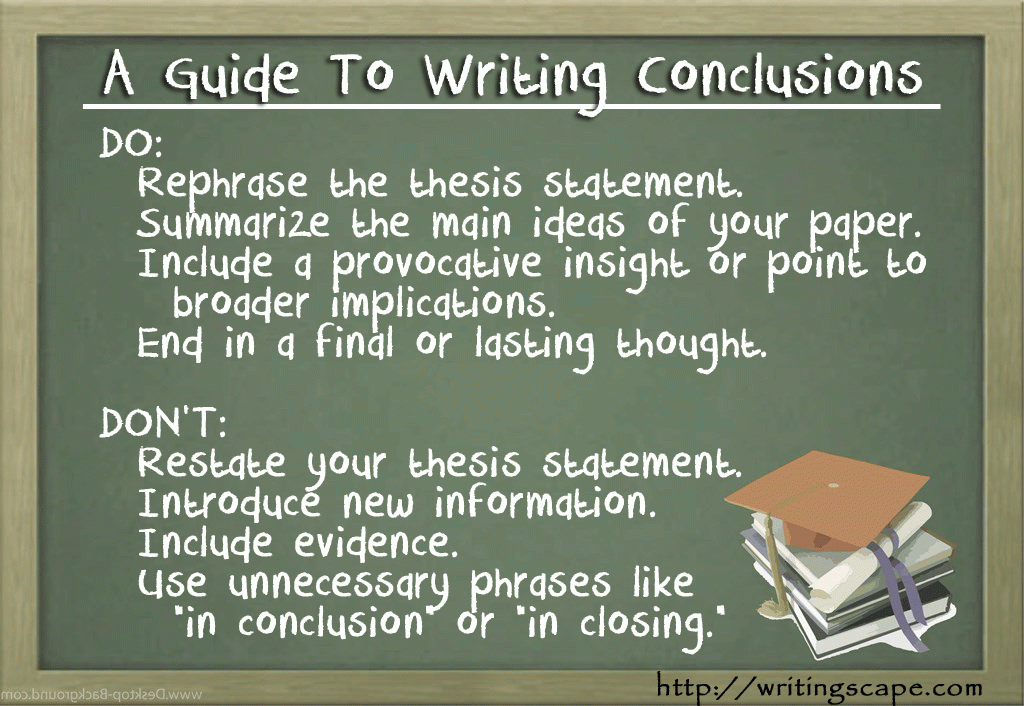A good conclusion is going to bring your overall work to its final stage. It is what will be most memorable about your document because it is the last thing your reader will have seen. Like your introduction, it is vital that you are considerate of your reader in your conclusion and that you are staying focused, unified, and clear.
Think of the conclusion as almost the reverse of an introduction. Where an introduction is going to move from a general topic idea to a specific goal through the thesis statement, the conclusion is going to reverse the process by moving from a specific goal through a rephrasing of the thesis statement, to a general idea that branches out into the reader’s life.
When you write a conclusion, you will want to start with a rephrasing of the thesis statement. Don’t just restate it! This should be rephrased as more of a concluding idea, rather than one you are about to argue.
Next, you should summarize and synthesize the main ideas of the paper. However, do not include new information or new evidence here. You shouldn’t be introducing things to the reader in the conclusion that weren’t already said before – it’s a conclusion only!
Finally, end in a lasting thought that your reader will take with them beyond the confines of this specific paper, project, document, or argument. Push beyond the scope of the work presented and help the reader make connections to this topic in their own life.
I like this guide to writing conclusions, which I think provides some helpful Do’s and Don’ts:

There are six major techniques that you can use in a conclusion:
- Summarize the main ideas
- Highlight the most important issue
- Ask a question that leaves the reader thinking
- Predict the future
- Offer a solution to the problem
- Call readers to take action
Shmoop also provides a great video that synthesizes how to write killer conclusions:
How to Write a Killer Conclusion by Shmoop
“Writing a Killer Conclusion by Shmoop”
In addition, I would share this great handout by UNC College of Arts & Sciences: “Conclusions,” which not only provides several helpful methods for writing good conclusions, but there is a list at the end of types of writing to avoid in a conclusion.
For instance, in the “Strategies to Avoid” section, you’ll see this great list:
- Beginning with an unnecessary, overused phrase such as “in conclusion,” “in summary,” or “in closing.” Although these phrases can work in speeches, they come across as wooden and trite in writing.
- Stating the thesis for the very first time in the conclusion.
- Introducing a new idea or subtopic in your conclusion.
- Ending with a rephrased thesis statement without any substantive changes.
- Making sentimental, emotional appeals that are out of character with the rest of an analytical paper.
- Including evidence (quotations, statistics, etc.) that should be in the body of the paper.
Overall, the most important factor to remember is that a conclusion is the conclusion. Like the end of a television series or movie, it should be tying together the pieces of what was seen previously into one final, cohesive moment. It shouldn’t introduce new information, but it should bring the reader back full circle to the introduction, reminding them of what they were reading, why it was important, and how those arguments were made.
Reference
University of North Carolina at Chapel Hill. (2013). Conclusions. Retrieved from http://writingcenter.unc.edu/handouts/conclusions/